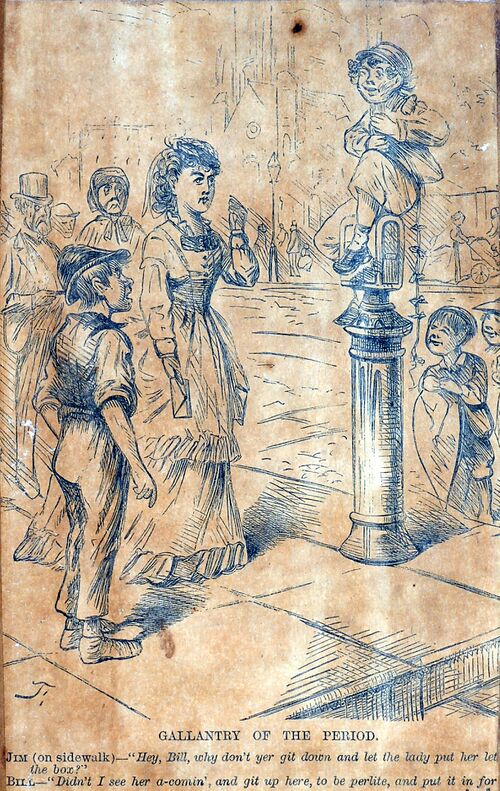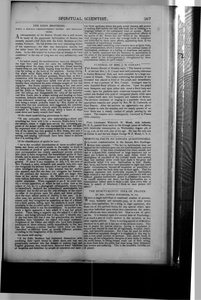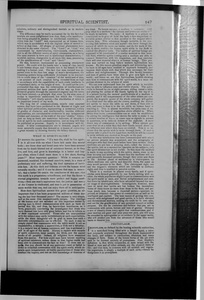
Legend


Gallantry of the Period
The Eddy Brothers
A correspondent of the Boston Herald who is well known to many of the prominent Spiritualists of Boston, has recently passed a few days with the Eddy Brothers at Chittenden, Vermont. He has written two very interesting letters of his experience; the first was descriptive merely, but the latter bears his opinion of the phenomena witnessed there. In the fifth seance he notices that an attempt at “test conditions" in the way of tying was not very satisfactory, and adds:
“As before stated, the manifestations were not delayed by the rope test,’ and soon out came the rollicking Honto, cavorting about the stage, dancing with Mrs. Stone, weaving shawls from air, and finally leaping from the floor of the hall over the railing at the front of the platform. Except during this slight aerial flight, which is really not up to the best achievements of an ordinary gymnast, Honto kept as firm a connection with the earth as any ordinary mortal, whereas, being a spirit, she might have sailed over all our heads and thereby have convinced the most obdurate sceptic of her real character. But Honto performs according to her own sweet will, being probably as indifferent to the opinions of the press and the public as William Eddy himself! As she bounded over the railings and disappeared, the voice of the materialized Mrs. Eaton, who is always waiting and bending on these occasions, defiantly referred to your correspondent as having at last witnessed something which he said he had not seen, that being a remark probably heard by ‘ Mrs. Eaton’ at the same time that test conditions were suggested, the conversation happening to occur directly under the window of a room occupied by William Eddy, during which a basin of slops came down and barely missed their mark.”
Of the shawl materializing phenomena he says:
“It was noticeable that after materializing a shawl and wreathing her form with it for a moment, Honto drew it into the cabinet, where it might have served the costuming purposes of the female spirits' who succeeded her, but the audibly expressed wish of your correspondent for a near examination of the fabric was only granted to Mrs. Stone, who said it was of a cotton-like texture. It seemed not unlike mosquito netting, and carping individuals have been heard to declare that it is nothing else.”
Of the identification of spirits he says:
“As to the so-called identification of these so-called spirit forms and faces, and which seems to the reader so much in the direction of proof of spirit return, it should be said that your correspondent has closely questioned several persons who claim to have recognized the materialized spirits of their friends, and in almost every instance has found them unable to assert that the resemblance was anything more than general. If there is any exception to this, it is the case of Mrs. Packard, a most estimable and amiable lady, who says she recognizes the delicate features of her spirit mother. Another intelligent lady, who is fully assured that her mother also appears, says that she does not recognize her features. On the contrary, the features of the spirit are larger than those of her mortal mother. Mr. Whittenmire, one of the most zealous defenders of the materialization claim, makes a similar admission. When requested to see if he could identify a certain apparition, of which he had a close view at the seance of July 30, by a photograph subsequently shown him, he immediately declared the resemblance unmistakable, but confessed that he did not see the side whiskers or the stand- up collar of the picture upon the ghost, and these perhaps were the most salient points of identity in this case. In another case two persons in the body of the hall at an Eddy seance said they recognized an apparition as that of a friend, but a third person, sitting upon the platform in much closer proximity to the so-called spirit, and equally interested in the identification, failed to see the resemblance. In another case, when a figure appeared, a lady asked if it was her grandmother. There being a negative tap, she asked if it was her mother; and being informed that it was, said ‘I identify you.’ If she had been told that it was her grandmother she would doubtless have ‘identified, the object with equal readiness. Neighbors of the Eddys and others who have been frequent attendants of these seances, testify unqualifiedly to the fact that, for instance, a certain familiar ‘spirit form’ has been ‘identified’ at different times as several different persons, according to the imagination of the identifier.”
He closes with saying:
“If the Eddy Brothers had contented themselves with exhibiting their ‘spirit forms’ in dumb show, and had not precariously ventured into the domain of oratory, logic and English grammar, they would have incurred fewer liabilities of suspicion and detection by people of education and taste; but those mediums whom the gods would destroy will persist in making their-spirits not only talk bosh, but in clothing it in language defiant of the commonest rules of syntax. Hence the terrible prosy, stereotyped and ungrammatical efforts of the spirits of Mr. Brown and the ‘Witch of the Mountain.’ And strange as it may seem the average circle is delighted and Eddy-fied by these same efforts, applauding them as the utterances of superhuman wisdom.
And now, after something over a week’s tarry at Spirit Vale, your correspondent, albeit a believer in the cardinal claims of Spiritualism, confesses to a feeling of weariness and satiety, and is hardly surprised that the tendency to materialism in the mind of the investigator who accompanied him and materially aided in his investigations, is strengthened by these preposterous claims of spirit return.”
<Untitled> (J. B. Shearer, a blacksmith of Stonersville)
...
<Untitled> (Protoplasm)
Protoplasm, as defined by the leading scientific author ties, is a semi fluid lining filled with a limpid liquid, a colorless corpuscle scattered throughout the whole framework of the body, and subject to contraction, dilatation and many changes of form. Some of the lowest forms of life are even said to be formed entirely of protoplasm. Prof. Huxley’s definition is. that white corpuscles, as seen mixed with the blood of man and all other animals, are the physical basis of life; and that man. in common with all animals and vegetable organisms. Is simply a multiple of such units,—hence he designates it as protoplasm.
Editor's notes
- ↑ image by unknown author
- ↑ Gallantry of the Period by unknown author
- ↑ The Eddy Brothers by unknown author, Spiritual Scientist, v. 2, No. 23, August 12, 1875, p. 267
- ↑ J. B. Shearer, a blacksmith of Stonersville by unknown author
- ↑ Protoplasm by unknown author, Spiritual Scientist, v. 1, No. 13, December 3, 1874, p. 147
Sources
-
Spiritual Scientist, v. 2, No. 23, August 12, 1875, p. 267
-
Spiritual Scientist, v. 1, No. 13, December 3, 1874, p. 147

